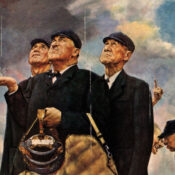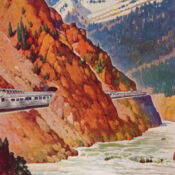Who says art museums have to be stuffy? You won’t find a single wall or frame in these six sometimes outrageous, always inspiring outdoor art galleries.
Neon Line Burning Man Gallery
Reno, Nevada
“A lot of the art we’re going to see today was first displayed at Burning Man,” says Jaime Chapman, kicking her pedicab into gear along Fourth Street in Reno, Nevada. “Do you know about Burning Man?”
I do, but by reputation only. The annual music-and-art festival springs to life in the desert about 100 miles northeast of here every September. The event has become known, in part, for its larger-than-life metal art installations. In the past decade or so, many of those works have found homes outside of Burning Man, including this half-mile-long stretch near Reno’s downtown.
“We’re gonna start here,” Chapman continues, making a U-turn at the corner of Fourth and Washington Streets. She stops and I take in the sidewalk scene from my canopied seat on the back end of Chapman’s hybrid bicycle/rickshaw.
“It’s a polar bear,” she says, which is quite unnecessary, because nobody is going to miss a 30-foot-tall polar bear glinting in 90-degree sun. Looking closer, I notice the bear seems to be made of numerous white metal plates.

“Those are recycled car hoods,” Chapman says, which makes sense, since environmental sustainability is a theme of Burning Man. But there are more than car hoods up there: Zoom in on the bear’s chest and you’ll see he’s proudly sporting a BMW medallion.
We continue down Fourth Street, along a strip of road that the developer, Jacobs Entertainment, is calling The Neon Line. There’s a lot of construction going on, and at times it appears that the art has shown up before the rest of the development was ready for it. Viewing the passing art parade, I’m glad I’m riding with Chapman — who owns Pineapple Pedicab — not just because it keeps my feet off the sidewalk on this hot summer day, but because Chapman is a font of Reno and Burning Man art lore. She seems to know every artist’s name and insider stories of how each and every work was created.
And there’s no denying the monumental impact of this art. There’s Broken but Together, a pair of highly polished 20-foot-high steel sculptures, each one possessing body parts missing in the other. Tara Mechani, made mostly of recycled machine parts, depicts a towering mashup of Buddha and a female robot. Bloom Sculpture, a fantasy plant with a metallic base, has wire-mesh blossoms that bob and dance in time with a musical soundtrack.

But my favorite piece of public Reno artwork comes at the end of our Fourth Street tour, in front of the Reno Bus station: A full-length bus sitting atop a 25-foot poll, angled upward at a steep 30-degree angle.

“That’s a real 1962 GM Fishbowl transit bus,” Chapman says. “The artists cut it in half, gutted it, and angled it to make it look like it’s taking flight.
“I talked to a guy who has to go in there and change the light bulbs. He says, man, it is scary inside!”
Topiary Park
Columbus, Ohio
When it comes to outdoor art, oversized metallic, stone, or concrete creations generally come to mind. But in a downtown Columbus park, a unique topiary garden — recreating one of the most famous Post-Impressionist paintings of all time — has been inspiring Ohioans for decades.
From most angles, the bushes and trees in Old Deaf School Park are clearly well-tended, but unremarkable. But find just the right spot on a curving sidewalk — helpfully designated by a bronze sign — and the plantings blend to form a remarkably faithful reproduction of George Seurat’s 1884 masterpiece Sunday Afternoon on the Island of La Grande Jatte.


Look closely and you’ll pick out the couple in the right foreground, complete with the cat rubbing against the women’s long skirt. In the middle distance, a parasoled woman strolls with a young girl. And in the distance, two figures walk away, so close their shoulders seem to fuse.
As far as anyone can tell, there is no art installation in the world anything like Columbus’s Sunday Afternoon. The artwork was dreamed up and created by Columbus artist James T. Mason and his wife Elaine, who shaped the original topiaries and placed the pond that was to represent the river scene.
Texas Tech University
Lubbock, Texas
Streaming between classes or pouring out of a Red Raiders football game, students at Texas Tech in Lubbock, Texas can’t help but be surrounded by impressive art: More than 100 major works dot the sprawling campus.
In fact, so expansive is the Texas Tech art collection that the school runs special buses with guided tours that point out themes of significant works.
It is a relatively quiet weekday as I sit on one of those red buses — oversized, open-air golf carts, really — and marvel at the sheer variety of art installations that seem to appear around every corner.
Some, like the monumental As Far as the Eye Can See — an enormous pair of granite circles that may be glasses or, possibly, portals to the future — impress with their sheer size and weight. One unique building-sized work, Oblique Intersection, has an imposingly blocky shape, but an ephemeral, transparent, almost smoke-like appearance.

Most startling, perhaps, is Run, an enormous metal sculpture that depicts five Texas Tech track athletes, frozen in mid-stride.
“Go ahead,” my guide says, “walk around it, and keep looking up.”
Remarkably, as I round the sculpture it seems to spring into action, depicting a single woman propelling herself toward the finish line. It’s an optical illusion created by the artist, accomplished with dozens of laser-cut layers of stainless steel.

That’s Texas for you: Settled in its ways but always on the move.
Edgewood Orchard Galleries
Door County, Wisconsin
Passing beneath an enormous sculpted owl suspended between two trees at the entrance to Edgewood Orchard’s outdoor gallery, I sense I am entering a true art space, albeit one defined by forest, ground, and sky.

Narrow, tree-lined hallways wind ahead of me, with each bend creating a setting for a piece of art: whimsical, contemplative, or boldly abstract. It is turning to fall here in Door County, where the long thumb of Wisconsin juts into the wild waters of Lake Michigan. The reds and golds of the sugar maples and Eastern hemlocks are deepening, and they create a lavish background for dozens of artworks that seem to spring up organically along the paths.
Sensibly distanced benches offer chances to rest and contemplate the three abstract birds that peek out from inside a schematic house frame; the anthropomorphized purple onion, its wide-eyed face frozen in surprise as it holds what appears to be a small blue dog; the soaring three-foot-wide dragonfly, seeming to buzz its way beneath the canopy of trees.

Once in a while, through the trees, I catch glimpses of Edgewood Orchard’s wooden building, an old barn where the same family has been curating gallery showings for more than 50 years. Yellow light radiates through its windows, inviting me in to the warmth.
But I think I’ll linger out here a while longer.
Mobile Bay Sculpture Garden and Oyster Trail
Mobile, AL
Tucked away in the upper reaches of Mobile Bay, The Azalea City has not one, but two outdoor art installations, each unique in its own way.
On the grounds of the Mobile Museum of Art, some 30 works covering a period of more than 60 years line a walk along the waters of Langan Park Lake. The styles range from pure traditional (Jo Hess’s bronze Flora, a kerchiefed woman contemplating a flower pot) to the wildly outrageous (my personal favorite: John Cerney’s Selfie, depicting people snapping pictures of themselves with rampaging dinosaurs).
Also around the bay, be on the lookout for the city’s decade-old Oyster Trail: dozens of three-foot-tall fiberglass oyster shells, imaginatively painted by many of the state’s leading artists. Don’t miss the shell at the corner of Dauphin and Conception Streets that depicts downtown Mobile as Vincent van Gogh might have seen it, or Mobile on the Half Shell at the east end of Spring Hill Avenue, a sumptuous vision of the city from Antebellum times to today.

The Hollywood Sculpture Garden
Los Angeles, CA
Even though you have to make a reservation to visit, and even though you have been told repeatedly that the collection is as quirky as any you will find anywhere, and even though you have to wind through endless residential streets and you’ll probably get lost before you find it, nothing can prepare you for your first steps into The Hollywood Sculpture Garden, tucked into a lush private yard just below the iconic Hollywood sign.
Hollywood Sculpture Garden (Uploaded to YouTube by Robby Gordon)
You will be greeted by the curator/homeowner, Dr. Robby Gordon, a former veterinarian/financial planner/mortgage broker who, about a decade ago, finally surrendered to his lifelong passion for art and threw himself into creating his own home-grown gallery.
Much of the work on display in the yard is his, but Dr. Gordon has also opened his exhibit space to more than 60 sculptors from around the world. The garden’s tightly wound trail ascends a steep hillside, bringing visitors within inches of the works, which range from meditative carved stone creations to colorful explosions of metal and plastic — and, most startlingly, a grouping of multicolored mannequins who seem to be contemplating the Los Angeles skyline in the distance.
The tour continues into Dr. Gordon’s house, which is stacked floor to ceiling with a cacophony of artworks.
Informality is the order of the day at the Hollywood Sculpture Garden, but that doesn’t mean you can just drop by. First, fill out a form on the website, then wait for Dr. Gordon to get back to you.
Trust me, it will be worth the wait.
Become a Saturday Evening Post member and enjoy unlimited access. Subscribe now




Comments
I’d love to see all of these Bill, logically starting with the Sculpture Garden, not far from where I live. Then maybe that 1962 GM Fishbowl transit bus in Reno. I’d be scared to go inside too, even though it’s obviously safe enough to change the light bulbs. It’s meticulously balanced, but still, the very idea of falling out of the back end is terrifying.